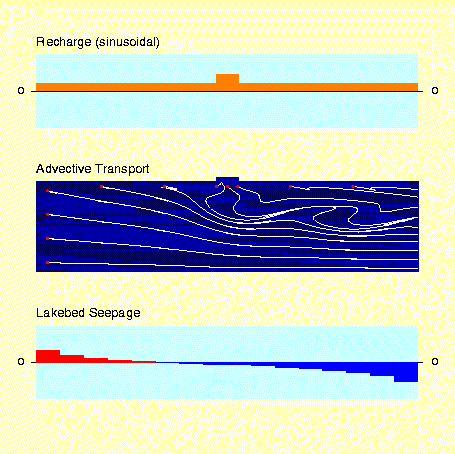Problem
Description
Non-dimensional
Ratios:
| Geometry |
| 2a /B |
0.25 |
Ratio of lake
length to aquifer depth. |
| 2a /LR |
0.02 |
Ratio of lake
length to regional length of aquifer. |
| LL
/LR |
0.5 |
Position of the
lake within the regional setting, normalised by
the regional length. |
| Aquifer Properties |
| KH /KV |
1 |
Hydraulic
conductivity anisotropy. |
| SoB |
1.0E-05 |
Aquifer elastic
storage coefficient. |
| Sy |
0.3 |
Aquifer specific
yield. |
| Boundary Fluxes |
| RLs
/Rs |
15 |
Ratio of average
lake recharge to average aquifer recharge. |
| RLaSy
/Ra |
0.5 |
Ratio
relating theamplitude of fluctuation in lake
recharge to the amplitude of aquifer recharge. |
| q /P |
|
The
phase difference between the lake and aquifer
recharges, normalised by the period. |
| System Response |
| LR2Sy
/KHBP |
0.469 |
Non-dimensional
response time describing the ability of the
lake-aquifer system to propagate periodic forcing
applied at the boundaries. |
| RsLR2
/KHB2 |
0.0586 |
A
non-dimensional measure of the mean height of the
regional groundwater mound above the groundwater
level at the regional discharge boundary. |
| RaP
/SyB |
0.4 |
Ratio
describing the size of potential fluctuation in
advective flowpaths relative to the aquifer
depth. |
|
Near-Field Animation
Flow-through-Recharge:
 |
| Animated
gif: 24 frames per period See
description below...
|
|
